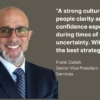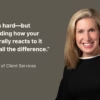
We have faced unprecedented change and loss of control over the last few months. People have lost jobs. Parents and caregivers have become homeschoolers. We’ve left our offices and colleagues to work remotely, and we’ve had a realization of how the workplace can shift and how companies can pivot quickly to meet demands. Our everyday norms are gone and it doesn’t seem realistic that they will return to what we knew before.
How do we prepare for what is next? What will it be like? Which companies will survive or thrive? Why those and not others? How does this impact our day-to-day success or the future of our teams? Look around, take an inventory of your team – there is a good chance it will look very different in a few months.
Recently, Boston Business Journal interviewed some local leaders who shared varying perspectives. Bob Reynolds, CEO and Chairman of Putnam Investments shared, “We are going to come back and things will be fundamentally changed.” Micho Spring, Weber Shandwick’s Global Corporate Practice Chair and New England President, reflected, “We are going to innovate our way out of this. I think our point of view is that, more than ever, communication needs to be driven by a company’s values — not only purpose, but also values.”
What does this mean for organizations and their teams? I feel now more than ever that entrepreneurial leaders are stepping forward. Leaders have the opportunity to create and reinforce a culture for their employees to develop growth mindsets and an ability to pivot and think in an entrepreneurial manner. Introducing values into their culture to accommodate risk, navigate uncertainty, explore ambiguity and innovation, fail fast and move forward, see problems, and look for solutions, will cultivate a new mindset. Employees at growth mindset companies are more committed to their work because they feel they have the potential to grow, thrive, and innovate within their organizations. A growth mindset can be highly transformative in any organization and it creates agility.
Arvind Krishna, CEO of IBM, carefully outlined this in this excerpt below from a letter he sent to all employees on his first day as CEO:
“Culture is everything. It’s what drives capability in any organization. One of my key priorities will be fostering an entrepreneurial mindset across our business. This is about being nimble, pragmatic and aiming for speed over elegance. And, it’s about being comfortable with ambiguity and continuously adapting to shifting circumstances.
All of this also needs to be complemented by a growth mindset. This is based on the understanding that we all have an enormous capacity for growth. But also, that learning is a continuous process—not an episodic event. Its a mindset driven by a quest for knowledge and passionate curiosity.”
Companies that have embraced creativity have brought about rapid innovation. For example, James Dyson, of vacuum cleaner fame, designed a new ventilator in just 10 days. Ford, GM, and Tesla are teamed up to produce ventilators for GE. Small manufacturers have shifted production to make necessary personal protection equipment. In every industry, organizations are bringing their most creative and solution-oriented ideas to market in record time.
How can this approach help companies make a comeback and re-engage their teams? Ben Bloch, Founder and CEO of Bloch Strategy, stated, “If you don’t look at yourself or your company as being entrepreneurial in spirit, you also probably don’t know that your company is losing customers to the 25 startups that have found a better way to build your widget.” Your employees need to be continuous learners and comfortable with “not knowing”. Let’s look at the difference between a fixed and growth mindset.
In a fixed mindset:
- People believe their qualities/traits are “set” and cannot be changed.
- People tend to state their intelligence and talents rather than continuing to develop and grow them.
- People feel their current state alone guarantees success and that additional effort is not required.
- People feel held back from making positive changes.
- People avoid situations and projects that are uncomfortable or not guaranteed to be successful.
In a growth mindset:
- People believe in continuous learning and growth with time and experience.
- People recognize their effort affects their success.
- People understand that extra time, listening, and learning lead to higher achievement.
- People feel they are always at a starting point for development and can grow and strengthen aptitudes.
How can you identify and enhance a growth mindset to help your organization become agile and thrive?
By understanding employees’ motivators and drives, you can help them shape your organization’s growth mindset. As a business leader, you need to be able to diagnose engagement and develop an action plan.
A critical success factor in any agile transformation is the growth mindset and behaviors of its leaders. Attitudes and values must shift towards agile aims of experimentation, innovation, creativity, and flexibility. To achieve success, there must be communication, commitment, and collaboration. The emerging discipline of talent optimization has several applications that can serve leaders making the shift. Here are some steps to address the talent optimization framework as shared by one our partners, Drew Fortin, SVP of Marketing and Sales at The Predictive Index, in his own words:
- Diagnose: Measure what matters. Understanding your team’s behavioral analytics with people’s similarities and differences can help business leaders understand where an agile approach is naturally well-suited for a given team member or where it may be a stretch for that person. What tools do you need to provide for your team to help them achieve their own growth mindset?
- Design: Select your organization’s structure. An agile strategydemands flexibility, adaptation, and efficient collaboration. It is critical that information flows quickly and easily and that efforts are guided by a shared sense of purpose and a clear goal. Continuous experimentation and learning are hallmarks of this type of organizational structure. How will you share your values and vision with your team to get them onboard?
- Hire: Determine candidate cultural fit. An agile organization requires innovation, collaboration, entrepreneurship, and a performance orientation. It’s important to integrate these valuesdeeply into the organization’s culture, starting from when you evaluate candidates for hire or promotion. Do your leadership team’s actions reflect your culture?
- Inspire: Create high-performing teams. Team dynamics are important to the successful execution of any business strategy, but an agile methodology places a premium on team communication, decision making, and execution. Communication in an agile organization is fast and furious. The teams must all strive to keep one another up-to-date on their respective purpose, goals, progress, and changes made in a dynamic environment. Agile organizations require swift action and response, so decision making must also be expedited. Finally, it’s important for an agile organization to have a bias for taking action. Boldness is always favorable in the pursuit of innovation and an entrepreneurial approach.
Organizations that adopt agile structures and methodologies aim to increase innovation, customer satisfaction, and operating efficiency, as well as generally increase in competitiveness and performance. Leaders who are able to adopt the mindset and behaviors required to execute this shift are well-positioned to create greater value for their organizations, their customers, and themselves. Talent optimization means keeping the four forces listed above top of mind with every people-related decision you make.
What steps will you take to achieve long term success and stimulate a growth mindset?
About MCG Partners
MCG Partners a woman-owned consultancy specializing in leadership, team and organizational development solutions. We help businesses optimize success through the entire management life-cycle. MCG Partners is also a Predictive Index® (PI®) certified partner. To learn more please contact John Griffith at john.griffith@mcgpartners.com and at mcgpartners.com.






